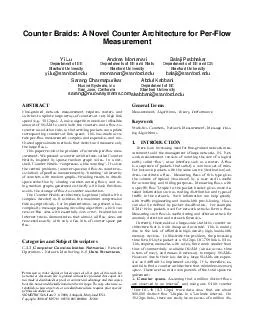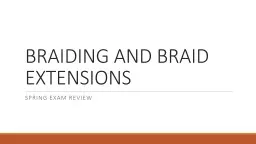PDF-Counter Braids A Novel Counter Architecture for PerFlow Measurement Yi Lu Department of
Author : briana-ranney | Published Date : 2014-12-27
lustanfordedu Andrea Montanari Departments of EE and Stats Stanford University montanarstanfordedu Balaji Prabhakar Departments of EE and CS Stanford University
Presentation Embed Code
Download Presentation
Download Presentation The PPT/PDF document "Counter Braids A Novel Counter Architect..." is the property of its rightful owner. Permission is granted to download and print the materials on this website for personal, non-commercial use only, and to display it on your personal computer provided you do not modify the materials and that you retain all copyright notices contained in the materials. By downloading content from our website, you accept the terms of this agreement.
Counter Braids A Novel Counter Architecture for PerFlow Measurement Yi Lu Department of: Transcript
Download Rules Of Document
"Counter Braids A Novel Counter Architecture for PerFlow Measurement Yi Lu Department of"The content belongs to its owner. You may download and print it for personal use, without modification, and keep all copyright notices. By downloading, you agree to these terms.
Related Documents


![http://cs273a.stanford.edu [BejeranoFall13/14]](https://thumbs.docslides.com/198537/http-cs273a-stanford-edu-bejeranofall13-14.jpg)

![http://cs173.stanford.edu [BejeranoWinter12/13]](https://thumbs.docslides.com/387613/http-cs173-stanford-edu-bejeranowinter12-13-575.jpg)
![http://cs173.stanford.edu [BejeranoWinter12/13]](https://thumbs.docslides.com/445066/http-cs173-stanford-edu-bejeranowinter12-13.jpg)
![http://cs273a.stanford.edu [BejeranoFall13/14]](https://thumbs.docslides.com/536015/http-cs273a-stanford-edu-bejeranofall13-14-.jpg)
![http://cs273a.stanford.edu [BejeranoFall14/15]](https://thumbs.docslides.com/538561/http-cs273a-stanford-edu-bejeranofall14-15.jpg)
![http://cs273a.stanford.edu [Bejerano Fall16/17]](https://thumbs.docslides.com/540408/http-cs273a-stanford-edu-bejerano-fall16-17-.jpg)
![http://cs273a.stanford.edu [BejeranoFall15/16]](https://thumbs.docslides.com/596167/http-cs273a-stanford-edu-bejeranofall15-16.jpg)




